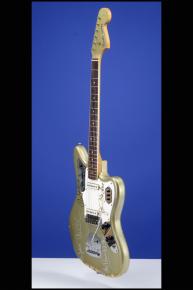Signed by the Original "Beach Boys"
This incredibly rare forty-four year old "Teal Green Metallic" Jaguar weighs 9.20 lbs. with a nut width of just under 1 11/16 inches and a scale length of 24 inches. Solid alder body, one-piece maple neck, and bound veneer rosewood fretboard with 22 frets and inlaid pearl dot position markers. Headstock with matching "Teal Green Metallic" finish and decal with "Fender" logo in gold with black trim, "JAGUAR" in black in bold letters beside it, and four patent numbers in black below it. With "Offset Contour Body" at the ball end of the headstock. Single "butterfly" string tree. Individual Fender "F" Tuners with octagonal metal buttons. "F-Series" neckplate with the serial number "150342" stamped between the top two screws and the neck dated: "15 APR 66 B." Two white oblong Strat-like pickups with notched metal side plates and balanced outputs of 5.60k and 5.68k. Three-layer (white/black/white) plastic pickguard with ten screws. Two controls (one volume, one tone) and jack socket on lower metal plate adjoining pickguard on treble side, selector switch and two roller controls (one volume, one tone) on upper metal plate adjoining pickguard on bass side, and three slide switches on metal plate inset into the pickguard on the treble side. The potentiometers are dated: "304 6617" (Stackpole, April 1966). Black plastic Jaguar knobs. Jazzmaster-type floating tremolo and bridge with six individual saddles and adjustable mute. Original white plastic tipped tremolo arm. There is some loss of finish on the bottom edge of the body and there are a few other small surface edge chips but overall this totally original 'surfers dream' guitar is in excellent (8.50) condition. Housed in a later Fender G & L black hardshell case with black plush lining (9.50).
This was the guitar that crested the wave of the 1960s golden age of surf music. If you wanted to hang ten, guitar-wise, this was the ax you played. Beach Boy Carl Wilson recorded and toured with a 1963 white Jaguar (now displayed in the Hard Rock Café – Orlando) and if you didn’t want to wipeout, you’d better have one, too. It was the coolest on the market, Fender’s top of the line, and the way shoot the curl and ride the tube to the Top Ten.. From San Onofre to Sunset Beach, Malibu and beyond, any other guitar was bogus. With this guitar in your hands you could reach the Glide, that spiritual place where surfer, board, and wave were in synch. The Fender Jag was a bitchin’ board that made beautiful, boss music.
Tony Andreason, lead guitarist for The Trashmen (Surfin’ Bird, 1964) used one. To Dave Gregory, lead guitarist for XTC, it was indispensable to the group’s success: ”I think the way that we got the sound we were known for is that we were playing Fender Jaguar guitars through Dual Showman amps. As a Beach Boys fan, I needed that authentic surf sound, just like Carl Wilson had on all those early hits”(http://www.guitargonauts.com/pick-21.html).
Signed with a silver permanent marking pen by Carl Wilson and Bruce Johnston, Mike Love and Al Jardine.
Autographed material of The Beach Boys is rare but can be found: albums covers, cards, etc. Autographed guitars, possibly, but we haven’t found any sale or auction records. An autographed vintage Jaguar signed by Carl Wilson, Al Jardine, Mike Love and Bruce Johnson is phenomenally scarce.
For most collectors, pre-CBS (pre-1966) Fender vintage guitars are the most desirable ones. Although CBS purchased Fender (officially) on January 3rd 1965, it took some time before the guitars changed. The "transition" era (late summer 1964 to December 1965) is known as a "transition" because later summer 1964 to December 1965 was the time when there was a transition from the Leo Fender management to CBS management, and mass-production manufacturing techniques were starting to take a firm hold. Of all pre-CBS Fender instruments, the period from summer 1964 to December 1965 was among Fender's high production periods. In late 1965 a white binding was added to the neck, but it was not until mid 1966 that the favored "dot" inlays were replaced by the "later-style" rectangular "pearl-block" markers.
Automobiles in the United States had more social influence than just about anything in the fifties and sixties and the vast array of colors that Fender used on their guitars during that period originated directly from the cars of the time. Teal Green metallic is a Lucite (acrylic) paint that was introduced in 1965 by the Lincoln Motor Company and used on their cars for only three years from 1965 until 1968. Fender followed suit and used it very sparingly on Jaguars, Jazzmasters, Stratocasters and Telecasters between 1965 and 1969. Teal Green Metallic is now one of the rarest and most sought after of all the Fender "custom colors". This is the color that will be missing from most collections…
Translate:













